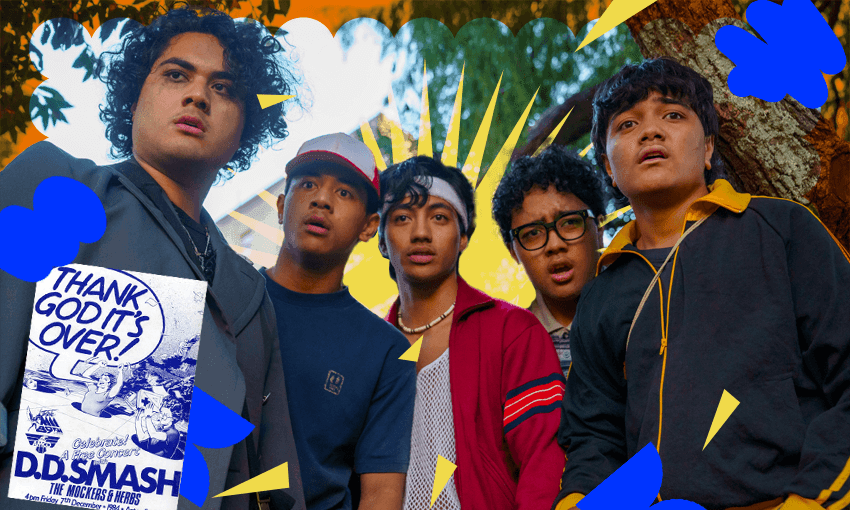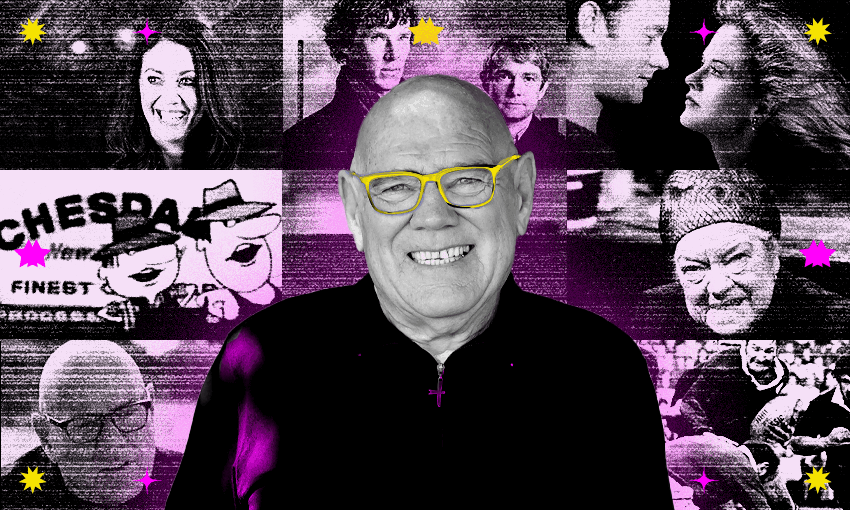Oscar Kightley faced plenty of obstacles making the Sione’s Wedding prequel. The biggest? Recreating the scene of a DD Smash concert that turned violent.
In December 1984, a concert called Thank God It’s Over! was held in Auckland’s Aotea Square to mark the end of the academic year. Headlined by DD Smash, the free afternoon show erupted in violence when the band’s frontman Dave Dobbyn spotted the cops and reportedly told the crowd: “I wish those riot squad guys would stop wanking and put their little batons away.”
Shops were looted. Windows were smashed. A car was overturned. Fires were lit. Blood was spilled.
Watching this chaos unfold from the West Auckland suburb of Te Atatū was a teenage Oscar Kightley. “I remember being at home watching TV and suddenly there was this eyewitness newsflash,” says the veteran local actor, writer and director. “I was agog, staring at what was unfolding … it was insane. People throwing shit through big plate glass windows, running in and helping themselves to whatever, running off up Queen Street. I’ll never forget that day.”
It’s this moment that Kightley chose to begin his new show Duckrockers, a TV prequel to his hit 2006 film Sione’s Wedding. The idea for a third film after 2012’s Sione’s 2: Unfinished Business had been kicking around for a while when South Pacific Pictures boss Andrew Szusterman suggested Kightley and co-writer James Griffin turn their prequel dreams into a TV show. Kightley agreed and with $4.3 million of NZ on Air funding secured, the pair began writing and producing the show, spending several months filming it earlier this year.
An origin story focused on the 80s upbringing of Siones Wedding’s core characters, much of Duckrockers is drawn from the Samoan-born Kightley’s real-life upbringing in West Auckland. Getting the markers of that time period correct – from haircuts to names, clothes and slang – was incredibly important. “We wanted to be really specific with it,” says Kightley. It was a time when video games were played in fish and chip shops and talking to people on the phone was through a landline in the hallway. “The audience will have a visceral connection with that stuff if you really get it right.”
In real life, Kightley was too young to attend the infamous Aotea Square concert. But in the first episode of Duckrockers, the show’s core group of four teens – that’s Sefa, Stanley, Michael and Albert for those who don’t remember the films – sneak onto a nearby rooftop to enjoy the show, and taste their first beer. Kightley and Griffin keep the posters and location the same, but rewrite history slightly when the riots are sparked not by Dave Dobbyn saying “wanking” but by the four kids throwing a beer bottle from the top of a nearby information centre into the crowd.
It was a fun idea, but filming those scenes became some of the hardest of the entire shoot. “That was a big day,” admits Kightley. “It was our biggest extras day … we had 20 minutes to film this huge scene.” He and his crew pulled it off by building fake platforms and filming from low angles, then mixing in the still-shocking footage from the actual riot. The results, seen in the first episode of Duckrockers, which premieres Wednesday on TVNZ 2 and TVNZ+, are as close to reality as they could get.
“We always thought it would be a challenge to recreate it,” Kightley says, but it was important to start his coming-of-age story here, because it was a moment of change in Aotearoa. “We went from a place where we trusted everyone to behave themselves and have a drink in public to being quite knowledgeable about how we would get up to mischief if the opportunity was there. It was quite a milestone day in our history and our evolution as a country … we knew that’s how we wanted to tackle this story.”
Recreating a famous riot wasn’t the only problem the Duckrockers crew faced. Chemistry was key to the success of Sione’s Wedding, with the cast of Kightley, Robbie Magasiva, Shimpal Lelisi and Iaheto Ah Hi already friends and members of the comedy troupe Naked Samoans well before filming began. As a result, their gags and effortless camaraderie oozed off the screen.
Finding the right actors to recreate the film’s loveable gang could make or break the prequel. Kightley knew the cast needed to gel, but he rejected the usual TV approach of hiring actors in their 20s and found real-life teenagers for the roles. “There’s a real innocence you have when you’re genuinely a teenager,” he says.
The chosen four – brothers Levi and Augustino Ieremia-Seulu, plus Duane Evans Jr and Dallas Halavaka – are aged between 14-18 and all still at school. Apart from the brothers, they were also all strangers to each other, but weeks of rigorous rehearsals helped them bond quickly. “Because of the pressure, because of the expectation, they’re really tight.”
They also needed to be able to dance. Duckrockers is full of “bopping” sequences as the boys form a breakdancing crew and begin facing up against a more practised local team. While Kightley says he’s never been able to dance, breakdancing was a big thing during his childhood. Some of the cast were so good they had to try and unlearn some of their tricks to make them look more like beginners.
The other issue creating a TV show in 2022? Covid. On a sunny but chilly day in May, the cast and crew were outside filming a bopping battle in Grey Lynn park. Dozens of actors were gathered around a cardboard mat lying on a basketball court with ghetto blasters scattered around. Nearby, an 80s police car was ready to speed onto the court to break up a looming fight. “Can we get on with the flipping battle?” yelled the opposition as the Duckrockers made their familiar hand gestures and “quack quack” call signs.
Laughing behind the monitor was Kightley. Everyone was masked except the actors, and Covid breaks became a regular occurrence during the shoot. “We lost actors, camera crew. Somehow we managed to soldier on,” he says. “Our protocols hung tight.”
But he couldn’t hide his delight at seeing his childhood depicted on screen. “It was a specific kind of innocence,” he says. “New Zealand was a more innocent country back then. Look at the TV, stuff like Top Town, the whole family would sit down to watch that. I couldn’t imagine that now.”
He’s hoping many do indeed sit down to watch Wednesday night’s debut of Duckrockers. Like Sione’s Wedding and Bro’ Town, Kightley’s pleased he’s managed to get faces just like his on local screens again. “There’s never been a show like this … about brown kids. I can’t remember one,” he says. “We got to make one. This is a huge deal for our community.”
Duckrockers airs on TVNZ 2 and TVNZ+ from Wednesday.



